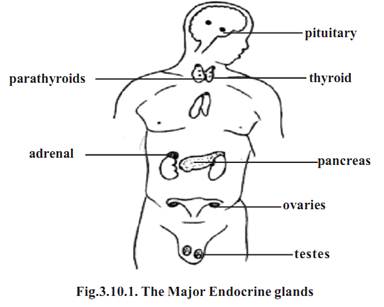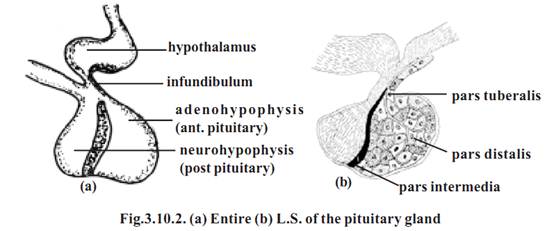


 النبات
النبات
 الحيوان
الحيوان
 الأحياء المجهرية
الأحياء المجهرية
 علم الأمراض
علم الأمراض
 التقانة الإحيائية
التقانة الإحيائية
 التقنية الحيوية المكروبية
التقنية الحيوية المكروبية
 التقنية الحياتية النانوية
التقنية الحياتية النانوية
 علم الأجنة
علم الأجنة
 الأحياء الجزيئي
الأحياء الجزيئي
 علم وظائف الأعضاء
علم وظائف الأعضاء
 الغدد
الغدد
 المضادات الحيوية
المضادات الحيوية|
Read More
Date: 16-7-2021
Date: 27-7-2021
Date: 30-7-2021
|
Endocrine system
Our body has two major regulatory systems. They are the nervous and endocrine systems. Together they regulate and co-ordinate the activities of all other body structures. The endocrine system sends information to the tissues it controls in the form of chemical signals. These signals, in the form of hormones are released into the circulatory system. They are carried to all parts of the body. Body cells are able to recognize the chemical signals and respond to them. The hormones of the endocrine glands regulate and control the functioning of several organs in the body. Thus, this system in general helps to maintain homeostasis. There are several endocrine glands in our body. The major glands are the pituitary, thyroid, parathyroid, pancreas, adrenals, testes and ovaries.

An understanding of the structure and form of each endocrine gland, its secretory products and the means by which its activity is regulated is absolutely essential. This knowledge will help us to treat several diseases related to these glands.
Pituitary gland (or) Hypothesis
It is an organ that secretes eight major hormones. These hormones regulate numerous body functions and controls the secretory activities of several other endocrine glands. The hypothalamus of the brain is connected to the pituitary. The posterior pituitary is an extension of the hypothalamus.
Structure of the pituitary gland.
This gland is approximately 1 cm in diameter. It weighs 0.5-1g. It is placed in a region called the sella turcica of the sphenoid bone in the floor of the skull. It is placed inferior to the hypothalamus. It is connected to it by a stalk of tissue called the infundibulum.
Based on origin and function the pituitary is divided into two parts. They are the posterior pituitary or neurohypophysis and anterior pituitary or adenohypophysis.

Posterior pituitary or Neurohypophysis.
The posterior pituitary is continuous with the brain. Hence it is called the neurohypophysis. During embryonic development, it is formed as an outgrowth of the inferior part of the brain in the area of the hypothalamus. The outgrowth of the brain forms the infundibulum. The distal end of the infundibulum enlarges to form the posterior pituitary. Since this part of the pituitary is an extension of the nervous system, its secretions are known as neurohormones.
Anterior Pituitary or Adenohypophysis
During embryonic development an out pocketing of the roof of the oral cavity arises. It is called as the Rathke’s pouch. This pouch grows towards the posterior pituitary. Later, the pouch loses its connection with the oral cavity and becomes the anterior pituitary. The anterior pituitary is subdivided into three areas. They are, the pars tuberalis, pars distalis and pars intermedia.
Relationship of the pituitary to the brain.
There is a network of blood vessels on the hypothalamus. It is called the primary capillary network. A portal system called the hypothalamohypophyseal portal system extends from a part of the hypothalamus to the anterior pituitary (a portal blood vessel begins and ends as capillaries). The portal system in turn opens into the secondary capillary network of the anterior pituitary. The neurohormones produced by the hypothalamus are collected by the primary capillary network. Through the portal system they enter into the secondary network of the anterior pituitary.
Thyroid gland
The thyroid gland is composed of two lobes. They are placed on the lateral sides of the upper portion of the trachea. These lobes are connected by a narrow band of thyroid tissue called the isthmus. The isthmus extends across the anterior aspect of the trachea.

The thyroid is one of the largest endocrine glands. It weighs approximately 20g. It is richly supplied with blood capillaries. It is more red than its neighboring tissues.
The gland is composed of numerous follicles. They are small spheres. Their walls are made up of cuboidal epithelial cells. The central cavity or lumen of each follicle is filled with a protein called the thyroglobulin. It stores large amount of thyroid hormone. The thyroid secretes thyroxine and calcitonin.
Parathyroid glands.
The parathyroid glands are found in association with the thyroid glands. They are found embedded in the posterior part of each lobe of the thyroid gland. There are four parathyroid glands. Inside the glands the cells are organized in densely packed masses. The cells of the glands secrete parathyroid hormone.
Adrenal glands or Suprarenal glands.
These glands are found near the superior pole of each kidney. They are surrounded by adipose tissue. The glands are enclosed by a connective tissue capsule.
The adrenal glands are composed of an inner medulla and outer cortex. These regions are formed from two separate embryonic tissues. The medulla consists of closely packed polyhedral cells. They are centrally located in the gland. The cortex is composed of smaller cells. These cells form three distinct layers, namely the zona glomerulosa, the zona fasciculata and the zona reticularis. These layers are structurally and functionally specialized.
The adrenal medulla secretes two major hormones. They are epinephrine (or adrenaline) and norepinephrine (or noradrenaline). The hormones of the adrenal cortex are the cortisol and aldosterone.
Pancreas.
The pancreas lies between the greater curvature of the stomach and the duodenum. It is an enlarged structure. It is approximately 15 cm long. It weighs 85 -100g.
The pancreas is both an exocrine and an endocrine gland. The endocrine part consists of pancreatic islets (islets of Langerhans). They are approximately 500,000 to 1,000,000 in number. The islets are distributed in the pancreas. The islets are composed of alpha (a) cells (20%) and beta (b)cells (75%). While the re cells secrete glucagon the b cells secrete insulin. A third type of cells called the delta (8) cells (5%) have been identified. These cells secrete somatostatin.
References
T. Sargunam Stephen, Biology (Zoology). First Edition – 2005, Government of Tamilnadu.



|
|
|
|
"عادة ليلية" قد تكون المفتاح للوقاية من الخرف
|
|
|
|
|
|
|
ممتص الصدمات: طريقة عمله وأهميته وأبرز علامات تلفه
|
|
|
|
|
|
|
ندوات وأنشطة قرآنية مختلفة يقيمها المجمَع العلمي في محافظتي النجف وكربلاء
|
|
|